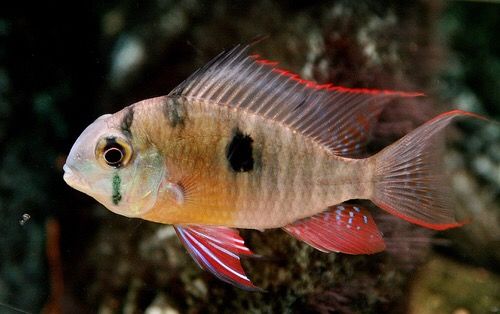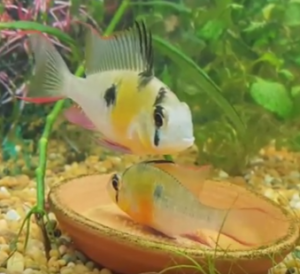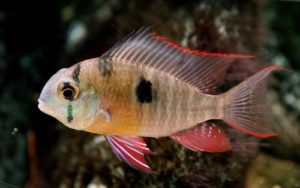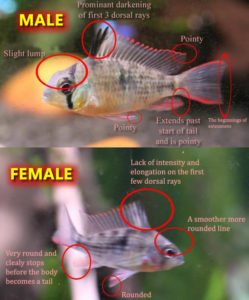
-

Bolivian Butterfly A very easy dwarf cichlid to care for is the very popular Bolivian Butterfly. With their interesting colour, mild mannered nature and ability to breed in the aquarium, they make great subjects for the home aquarium.
Common Name(s) : Bolivian Butterfly, Bolivian Ram
Family : Cichlidae Sub Family: Geophaginae
Genus: Mikrogeophagus
Species : Mikrogeophagus altispinosus
Origin : Bolivia, Brazil (Amazon Basin)
PH : 6.0 – 7.4
Hardness : Soft to Moderate
Temperature : 22 – 28°C / 71.6–82°F
Maximum Size : 8cm / 3.2 inches
Lifespan : 4-5 years
Aggression Level : Low (2/10) Only aggressive whilst breeding
Recommended Tank Size : 30 Litres +
Strata : Bottom
DESCRIPTION
The Bolivian Butterfly is a small colourful fish with an elongated oval shaped body and pointed fins and tail. Mature males have a point at the end of their dorsal fin and longer filaments on the tail fin than the females.
The body has an overall colour of silver/grey. They can be yellow on the front half and have a whitish yellow belly. They may have a black spot in the middle of their body below the middle area of the dorsal fin, and may or may not have a crescent vertical black line that runs through their eyes. The tips of the dorsal fin and the edges of the tail fin are orange, and the anal and pectoral fins are orange as well.
TANK SET UP
Provide rocks, large pieces of driftwood, live or fake plants etc for lots of cover
 SUITABLE TANK MATES
SUITABLE TANK MATES
- Angelfish
- Barbs
- Dwarf Cichlids
- Dwarf Gouramis
- Bristlenose
- Corydoras
- Danios
- Flying Fox
- Guppies
- Loaches
- Mollies
- Plants
- Platys
- Rainbows
- Rasboras
- Sharks
- Silver Dollars
- Snails
- Swordtails
- Tetras
DIET
Omnivores – Frozen, Live, Flakes, Pellets, Vegetables
It is recommended feeding foods high in beta-carotene to enhance colouration of these fish. There are colour enhancing sinking pellets available or you can simply feed them frozen brine shrimp which is rich in beta-carotene.

SEXING AND BREEDING
Male’s first few rays of the dorsal fin are black and both the dorsal and caudal fin are edged in a pinkish red. The anal and pelvic fins are the same shade of red throughout with bright blue rays and dots.
Generally a males Bolivian Butterfly is much more colourful than a female
To give every chance for mature Bolivian Butterfly’s (mature after around 9-10 months) to breed, feed the fish a high protein diet (perhaps twice a day with one of those feeds being a frozen bloodworm or brine shrimp) for probably two weeks or so.
You can tell when the male Bolivian Butterfly is interested in breeding because his colours increase and his behaviour changes. He tries to get his mates attention by doing things like flaring its throat and gills, curling its body, body whipping and tail lashing. The female Bolivian Butterfly may return some of his advances, or may completely ignore him.
The male will then prepare potential spawning sites, such as cleaning stones, driftwood or a cave. The male will often engage in shaking over the intended site, and pick at the substrate with his mouth repeatedly while the female looks on. The male may also construct a large depression in the substrate, and even partially construct several more depressions during courting.
The female will also engage in constructing these nests, but not to the degree of the male. When the female begins taking keen interest in cleaning a spawning site, typically spawning is imminent. During courting the degree of aggression is quite varied, sometimes the male is content to casually follow the female around, and other times, the same male will outright harass the female, however no damage is ever inflicted; ample cover for the female is necessary for this reason.
An adult pair can spawn every 3 weeks, and most aggression is confined to the intermittent period between spawns, or early in the courting process. After the female has developed eggs and shows interest in the male’s advances, any aggression is converted to the dramatic courting displays previously mentioned.
The chosen nest site commonly on flat rock, a depression in the substrate, driftwood, on a heater or internal filter edge or on broad leaved plants. The pair will clean the chosen surface until the female begins laying eggs, gliding in a circular motion, depositing 6-10 eggs at a time. She will then give way, and the male will fertilize the eggs in a similar fashion. This process of exchange may continue for up to an hour.
Clutch sizes seem to vary; young females may lay as few as 60 eggs, while adult females can lay 200. Parents may cover the clutch in ssubstrate 45-60 minutes after spawning is complete, and remove it after 36-48 hours.
The pair will take turns fanning the eggs to keep them from turning into fungus and the each defend the territory from the other fishes in the aquarium.
In 24 hours, the eggs will turn an orange-amber color, and unfertilized eggs may begin to turn white, along with those that fungus despite fertilization. Eye spots are clearly visible on the second day.
The eggs hatch after 2 and a half to three days and are immediately transferred by both parents into the pre-constructed nests. During the egg stage, the male will begin constructing these nests for the wigglers, this usually happens late in the egg stage, within 12 hours of hatching.
The pair continues to maintain shifts of fanning the young fry, and will constantly mouth and tumble the larvae.
The fry are free-swimming after seven days, and are initially kept herded into a shallow depression by both parents, which are most aggressive during this time, however, they are still quite mild mannered and seem content to just keep the other fishes on the other side of the tank, without damaging the other fishes.
Baby fry can be fed frozen baby brine shrimp after about day 5-7.
OTHER USEFUL INFORMATION
In it’s natural habitat, Bolivian Butterfly’s are found in streams, pools, and lagoons with dense vegetation and submerged branches and roots that offers shaded areas and plenty of hiding places in the Amazon Basin of Bolivia and Brazil.
They mostly inhabit the mid and bottom regions of these areas and feed by sifting the fine substrate for plant material and small organisms. They will also feed on organisms in the water and sometimes at the surface.
Mikrogeophagus altispinosus is an undervalued species in the aquarium hobby. They are impressively coloured, don’t get too big, will eat most foods, and they can adapt to a diverse number of water conditions with ease.
Since Mikrogeophagus altispinosus is not as finicky as many other cichlids when it comes to these requirements it is definitely worth a look. If you want a colourful, peaceful dwarf cichlid for a planted community or, if you have had trouble keeping Mikrogeophagus ramirezi (Blue Ram) in the past and would like something similar that is not as demanding, the Bolivian Butterfly maybe just what you are after!
